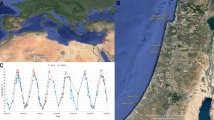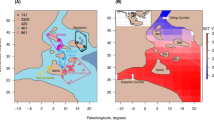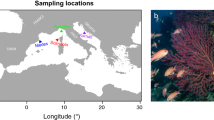Abstract
Recent investigations of the more than 100 inland marine caves of Bermuda have shown that the number of invertebrate species inhabiting them is large, the amount of endemism is greater than one might expect, and the biogeographical relationships among species of certain genera encountered suggest more than one route of colonization. We believe that some of Bermuda's cavernicolous invertebrate marine fauna originated from stocks transported from the Caribbean via the Gulf Stream; some may represent groups that survived on submerged and emergent sea mounts along the Mid-Atlantic Ridge since the middle Mesozoic; some are relict deep sea fauna, while others may be Tethyan relicts. In addition, we hypothesize that the geothermal temperature gradient, observed as shallow as 30m below present sea level1, may have maintained water temperatures in some caves sufficiently high to protect certain groups during Pleistocene glaciation.
This is a preview of subscription content, access via your institution
Access options
Subscribe to this journal
Receive 51 print issues and online access
$199.00 per year
only $3.90 per issue
Buy this article
- Purchase on SpringerLink
- Instant access to full article PDF
Prices may be subject to local taxes which are calculated during checkout
Similar content being viewed by others
References
Hyndeman, R. D., Muecke, G. K. & Aumento, F. Can. J. Earth Sci. 11, 809–818 (1974).
Sket, B. & Iliffe, T. M. Int. Revue ges. Hydrobiol. 65, 871–882 (1980).
Hart, C. W. Jr & Manning, R. B. J. Crust. Biol. 1, 441–456 (1981).
Bowman, T. E. et al. J. Crust. Biol. (in the press).
Reynolds, P. H. & Aumento, F. Can. J. Earth Sci. 11, 1269–1273 (1974).
Schenk, P. E. EOS 54, 486 (1973).
Harmon, R. S. Can. Caver 6, 52–57 (1974).
Palmer, A. N., Palmer, M. V. & Queen, J. M. in Proc. 7th int. Congr. Speleol., 336–339 (1977).
MacArthur, R. H. & Wilson, E. O. The Theory of Island Biogeography (Princeton University Press 1967).
Sterrer, W. & Sterrer, C. Marine Fauna and Flora of Bermuda (Wiley-Interscience, New York, in the press).
McIntyre, A. et al. Geol. Soc. Am. Mem. 145, 43–75 (1976).
Briggs, J. C. Syst. Zool. 15, 153–163 (1966).
Chace, F. A. & Manning, R. B. Smithson. Contr. Zool. 131, 1–18 (1972).
Wilkins, H. & Parzefall, J. Annls. Spéléeol. 29, 419–434 (1974).
Monod, T. & Cals, P. Miss. Zool. Belge Iles Galapagos Ecuador 2, 57–103 (1970).
Holthuis, L. B. Zool. Verh., Leiden 128, 1–48 (1973).
Redfield, A. C. Science 157, 687–692 (1967).
Hobbs, Horton H. Jr & Hart, C. W. Jr Smithson. Contr. Zool. 364, 1–148 (1982).
Author information
Authors and Affiliations
Rights and permissions
About this article
Cite this article
Iliffe, T., Hart, C. & Manning, R. Biogeography and the caves of Bermuda. Nature 302, 141–142 (1983). https://doi.org/10.1038/302141a0
Received:
Accepted:
Issue date:
DOI: https://doi.org/10.1038/302141a0
This article is cited by
-
Development of anchialine cave habitats and karst subterranean estuaries since the last ice age
Scientific Reports (2019)
-
Diversity and evolution of the stygobitic Speleonerilla nom. nov. (Nerillidae, Annelida) with description of three new species from anchialine caves in the Caribbean and Lanzarote
Marine Biodiversity (2019)
-
Historical biogeography of the genus Polycopissa (Ostracoda: Myodocopa: Cladocopina), with the description and DNA barcode of the second Indo-Pacific species from the Seto Inland Sea
Marine Biodiversity (2016)
-
On the genus Thaumatoconcha Kornicker and Sohn (Halocyprida) with description of two new species from Southern Ocean deep sea
Helgoland Marine Research (2012)
-
Nutrient speciation and hydrography in two anchialine caves in Croatia: tools to understand iodine speciation
Hydrobiologia (2011)



